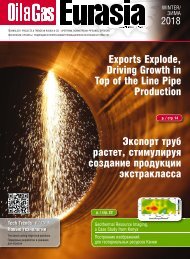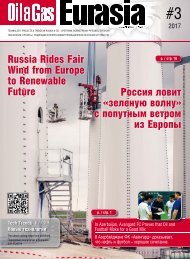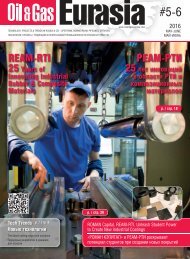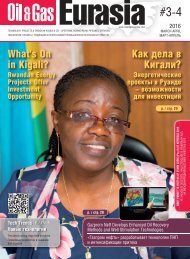Create successful ePaper yourself
Turn your PDF publications into a flip-book with our unique Google optimized e-Paper software.
TECH TRENDS<br />
Tomsk, which is engaged in the development<br />
of hard to recover reserves<br />
extraction technologies, can adapt<br />
them for the use in the Arctic conditions,<br />
the Institute press service<br />
reported.<br />
Potential reserves in the Russian<br />
Arctic are estimated at 100 billion toe<br />
(tons of oil equivalent), or 25% of the world's resources.<br />
By 2030, the production of hydrocarbons in the Arctic<br />
will increase by 2.5 times.<br />
«The main trends of recent years are the shift of production<br />
to the north and the prevalence of heavy oil in<br />
the reserves structure. Now 65 percent of Russian fields<br />
are the fields with hard to recover reserves,» said IPC<br />
director Lyubov Altunina.<br />
Enhanced recovery is one of the directions of IPC<br />
SB RAS activities. Institute has developed 11 industrial<br />
technologies for the fields in Western Siberia and Komi<br />
Republic, adjacent to the Arctic zone. And these methods,<br />
according to the head of IPC can be easily adapted<br />
to extreme offshore conditions.<br />
«Reagents for the Arctic need to work at low temperatures,<br />
they should be easily dissolved and pumped,”<br />
said Altunina. “For example, we make oil-displacing<br />
compositions with freezing temperatures ranging from<br />
-20 to -60 degrees. You can use them with the equipment<br />
which the oilmen already have. They are easy to prepare<br />
and inject. Of no less importance is the fact, that we use<br />
the reagents beyond the fourth class of danger, that is,<br />
low-hazard or safe for humans and the environment,»<br />
she adds.<br />
<strong>#1</strong> <strong>2017</strong><br />
Томский Институт химии<br />
нефти готов адаптировать<br />
свои технологии для Арктики<br />
Институт химии нефти (ИХН) СО РАН<br />
в Томске, который занимается разработкой<br />
технологий добычи «трудной» нефти,<br />
может адаптировать их для работы в условиях<br />
Арктики, сообщает пресс-служба института.<br />
Потенциальные запасы российской Арктики оцениваются<br />
в 100 млрд ТНЭ (тонн в нефтяном эквиваленте),<br />
или 25 % мировых ресурсов. К 2030 году добычу углеводородов<br />
в Арктике планируется увеличить в 2,5 раза.<br />
«Основные тенденции последних лет — это движение<br />
добычи на север и превалирование в запасах высоковязкой<br />
нефти. Сейчас в России месторождений с трудноизвлекаемыми<br />
запасами уже 65 процентов», — говорит<br />
директор ИХН Любовь Алтунина.<br />
Увеличение нефтеотдачи — одно из направлений<br />
деятельности ИХН СО РАН. Специалисты института разработали<br />
11 промышленных технологий для месторождений<br />
Западной Сибири и Республики Коми, прилегающих<br />
к Арктической зоне. И эти методы, по словам<br />
руководителя ИХН, могут быть легко адаптированы для<br />
экстремальных условий шельфа.<br />
«Реагенты для Арктики должны работать при низких<br />
температурах, легко растворяться и перекачиваться,<br />
— отмечает Любовь Алтунина. — Мы делаем, например,<br />
нефтевытесняющие композиции, температура замерзания<br />
которых колеблется от -20 до -60 градусов. С ними<br />
можно работать той техникой, которая уже есть у нефтяников.<br />
Они просты в приготовлении и закачке. Что не<br />
Rospan International Conducted a Record<br />
Fracturing Operation Using Technology of<br />
Creating Highly Conductive Fractures<br />
Rospan International, Rosneft subsidiary,<br />
at the end of 2016 conducted at the East<br />
Urengoi license area record for gas-condensate<br />
field hydraulic fracturing (HF) operation<br />
with the use of technology creating highly<br />
conductive fractures. Once in 7 hours 385<br />
tons of proppant have been pumped in the<br />
reservoir, which is equivalent to 700 tons of<br />
proppant injected with the use of conventional<br />
methods. It allowed to create highly<br />
conducting fracture, which provided high<br />
well flow rate – more than 600 thousand<br />
cub. m / day of gas and more than 200 tons<br />
/ day of gas condensate.<br />
To set a record HF, additional pumping and capacitive equipment was<br />
used, a special carrier fluid was developed, retaining its properties during<br />
long-term pumping. This technology provides higher hydraulic fracture size<br />
and increases the productivity of wells at 5-7%.<br />
The previous record was set in the company at the beginning of 2016,<br />
when 300 tons of proppant was pumped into the wellbore during HF operation,<br />
which is equivalent to 550 tons of proppant injected with the use of<br />
conventional methods.<br />
«Роспан Интернешнл» провел<br />
рекордный ГРП по технологии создания<br />
высокопроводящих трещин<br />
«Роспан Интернешнл», дочернее общество НК<br />
«Роснефть», конце 2016 года провел на Восточно-<br />
Уренгойском лицензионном участке рекордную для<br />
газоконденсатного месторождения операцию гидроразрыва<br />
пласта (ГРП) по технологии создания высокопроводящих<br />
трещин. Единоразово в течение 7 часов<br />
в пласт было закачано 385 тонн проппанта, что эквивалентно<br />
700 тоннам проппанта, закачанного по традиционной<br />
технологии. Это позволило создать высокопроводящую<br />
трещину, которая обеспечила высокие дебиты<br />
скважины – более 600 тыс м3/сут газа и более 200 т/<br />
сут газового конденсата.<br />
Для выполнения рекордного ГРП было привлечено<br />
дополнительное насосное и ёмкостное оборудование,<br />
разработана специальная рецептура жидкости-носителя, сохраняющая её<br />
свойства при длительной закачке. Применение данной технологии обеспечивает<br />
более высокие эквивалентные объемы трещины ГРП и позволяет увеличить<br />
продуктивность скважин на 5-7%.<br />
Предыдущий рекорд на предприятии был установлен в начале 2016 года,<br />
когда в скважину в рамках проведения ГРП было закачано 300 тонн проппанта,<br />
что эквивалентно 550 тоннам проппанта, закачанного по традиционной технологии.<br />
14<br />
For more Tech Trends, visit www.oilandgaseurasia.com<br />
o<br />
Oil&<strong>Gas</strong>EURASIA











